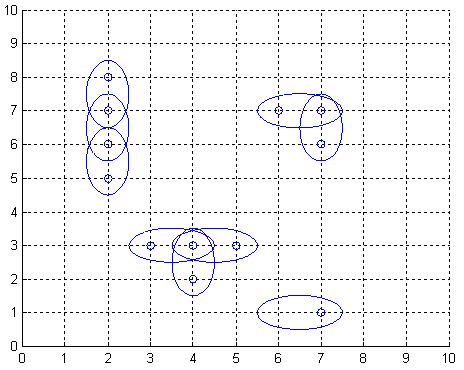CUGB图论专场2:A - Antenna Placement 二分图最小边覆盖
来源:互联网 发布:linux中的find命令 编辑:程序博客网 时间:2024/06/07 09:41
A - Antenna Placement
Time Limit:1000MS Memory Limit:65536KB 64bit IO Format:%I64d & %I64uDescription
The Global Aerial Research Centre has been allotted the task of building the fifth generation of mobile phone nets in Sweden. The most striking reason why they got the job, is their discovery of a new, highly noise resistant, antenna. It is called 4DAir, and comes in four types. Each type can only transmit and receive signals in a direction aligned with a (slightly skewed) latitudinal and longitudinal grid, because of the interacting electromagnetic field of the earth. The four types correspond to antennas operating in the directions north, west, south, and east, respectively. Below is an example picture of places of interest, depicted by twelve small rings, and nine 4DAir antennas depicted by ellipses covering them.

Obviously, it is desirable to use as few antennas as possible, but still provide coverage for each place of interest. We model the problem as follows: Let A be a rectangular matrix describing the surface of Sweden, where an entry of A either is a point of interest, which must be covered by at least one antenna, or empty space. Antennas can only be positioned at an entry in A. When an antenna is placed at row r and column c, this entry is considered covered, but also one of the neighbouring entries (c+1,r),(c,r+1),(c-1,r), or (c,r-1), is covered depending on the type chosen for this particular antenna. What is the least number of antennas for which there exists a placement in A such that all points of interest are covered?

Obviously, it is desirable to use as few antennas as possible, but still provide coverage for each place of interest. We model the problem as follows: Let A be a rectangular matrix describing the surface of Sweden, where an entry of A either is a point of interest, which must be covered by at least one antenna, or empty space. Antennas can only be positioned at an entry in A. When an antenna is placed at row r and column c, this entry is considered covered, but also one of the neighbouring entries (c+1,r),(c,r+1),(c-1,r), or (c,r-1), is covered depending on the type chosen for this particular antenna. What is the least number of antennas for which there exists a placement in A such that all points of interest are covered?
Input
On the first row of input is a single positive integer n, specifying the number of scenarios that follow. Each scenario begins with a row containing two positive integers h and w, with 1 <= h <= 40 and 0 < w <= 10. Thereafter is a matrix presented, describing the points of interest in Sweden in the form of h lines, each containing w characters from the set ['*','o']. A '*'-character symbolises a point of interest, whereas a 'o'-character represents open space.
Output
For each scenario, output the minimum number of antennas necessary to cover all '*'-entries in the scenario's matrix, on a row of its own.
Sample Input
27 9ooo**oooo**oo*ooo*o*oo**o**ooooooooo*******ooo*o*oo*oo*******oo10 1***o******
Sample Output
175
题意:给出'*‘代表城市,求最少的基站能够覆盖所有的城市,一个基站能覆盖两个相邻的城市。
思路:基站其实就是一条边,就是求最小边覆盖。
而边覆盖数+边独立数=顶点数。
即最小边覆盖数=顶点数-边独立数,边独立数又叫做最大匹配数。所以求出最大匹配数就可以了。而建图比较难,这题想了好久,其实因为一个基站能覆盖相邻的城市,所以把每个城市及其上下左右相邻的加入二分图就可以了,可以用邻接表实现,用vector代替平常的邻接表。而这些城市最先得先加序号,因为匈牙利算法中要标号,如果不加序号的话,那么就不能标号了,也会标号混乱,不易实现。
#include <iostream>#include <cstdio>#include <fstream>#include <algorithm>#include <cmath>#include <deque>#include <vector>#include <list>#include <queue>#include <string>#include <cstring>#include <map>#include <set>#define PI acos(-1.0)#define mem(a,b) memset(a,b,sizeof(a))#define sca(a) scanf("%d",&a)#define pri(a) printf("%d\n",a)#define MM 10002#define MN 505#define INF 168430090using namespace std;typedef long long ll;int n,h,w,t,m,pre[MN],vis[MN];vector<int>q[MN];int dfs(int x){ for(int i=0; i<q[x].size();i++) { int y=q[x][i]; if(!vis[y]) { vis[y]=1; if(pre[y]==0||dfs(pre[y])) //dfs前向结点,如果为真说明找到增广路 { pre[y]=x; //把匹配的变成未匹配,未匹配的变成匹配,故匹配数+1,因为未匹配数比匹配数大1 return 1; } } } return 0;}void search(){ for(int x=1; x<n; x++) //从左顶点集开始判断 { mem(vis,0); if(dfs(x)) m++; }}int main(){ cin>>t; while(t--) { char Map1[40][11]; int i,j,k,Map[40][11],dis[4][2]= {0,1,0,-1,-1,0,1,0}; n=1; m=0; mem(Map,0); mem(pre,0); cin>>h>>w; for(i=0; i<h; i++) cin>>Map1[i]; for(i=0; i<h; i++) for(j=0; j<w; j++) if(Map1[i][j]=='*') Map[i][j]=n++; //顺序加序号 for(i=0;i<=503;i++) q[i].clear(); for(i=0; i<h; i++) for(j=0; j<w; j++) { int a,b,x=Map[i][j]; if(x) for(k=0; k<4; k++) { a=i+dis[k][0]; //把上下左右的点符合的加入二分图 b=j+dis[k][1]; if(a>=0&&a<h&&b>=0&&b<w&&Map[a][b]) q[x].push_back(Map[a][b]); } } search(); cout<<n-1-m/2<<endl; //因为是无向图,而匈牙利算法中是有向的,所以每条边匹配了两次。比如:4和5,第一次匹配了4->5,第二次又匹配了5->4,故除2 } return 0;} 0 0
- CUGB图论专场2:A - Antenna Placement 二分图最小边覆盖
- POJ3020 Antenna Placement【二分图最小边覆盖】
- CUGB图论专场2:B - Asteroids 二分图:最小顶点覆盖=最大匹配数
- [最小路径覆盖、二分图最大匹配]Pku3020--Antenna Placement
- 【二分图+最小路径覆盖】北大 poj 3020 Antenna Placement
- POJ 3020Antenna Placement(二分图最小顶点覆盖)
- poj 3020 Antenna Placement 二分图最小路径覆盖
- POJ 3020 Antenna Placement ,二分图的最小路径覆盖
- POJ - 3020 Antenna Placement 二分图 最小路径覆盖
- Poj 3020 Antenna Placement (二分图最小路径覆盖)
- POJ 3020 Antenna Placement(二分图最小路径覆盖)
- [POJ 3020]Antenna Placement[二分图最小路径覆盖]
- poj_3020 Antenna Placement(二分图最小路径覆盖)
- POJ3020 Antenna Placement(二分图最小路径覆盖)
- POJ 3020 Antenna Placement(无向图最小边覆盖)
- poj3020 Antenna Placement(无向图最小边覆盖)
- POJ 3020:Antenna Placement(无向二分图的最小路径覆盖)
- POJ 3020-Antenna Placement(二分图匹配_最小路径覆盖+前向星构图)
- 《学习OpenCV》打印矩阵
- Fighting (完全背包问题)
- 理解JavaScript的caller,callee,call,apply
- 把过程与函数说透
- 小P寻宝记(01背包)
- CUGB图论专场2:A - Antenna Placement 二分图最小边覆盖
- 把触发器说透
- nginx下使用cgi也可以像apache一样了!
- 自定义ScrollView 下拉上拉回弹,阻尼效果
- emacs个人配置
- 自制45度2D引擎之坐标转换
- 《学习OpenCV》练习3-4
- 【quick-x】学习笔记(基本代码段)
- 为什么寄存器比内存快?


